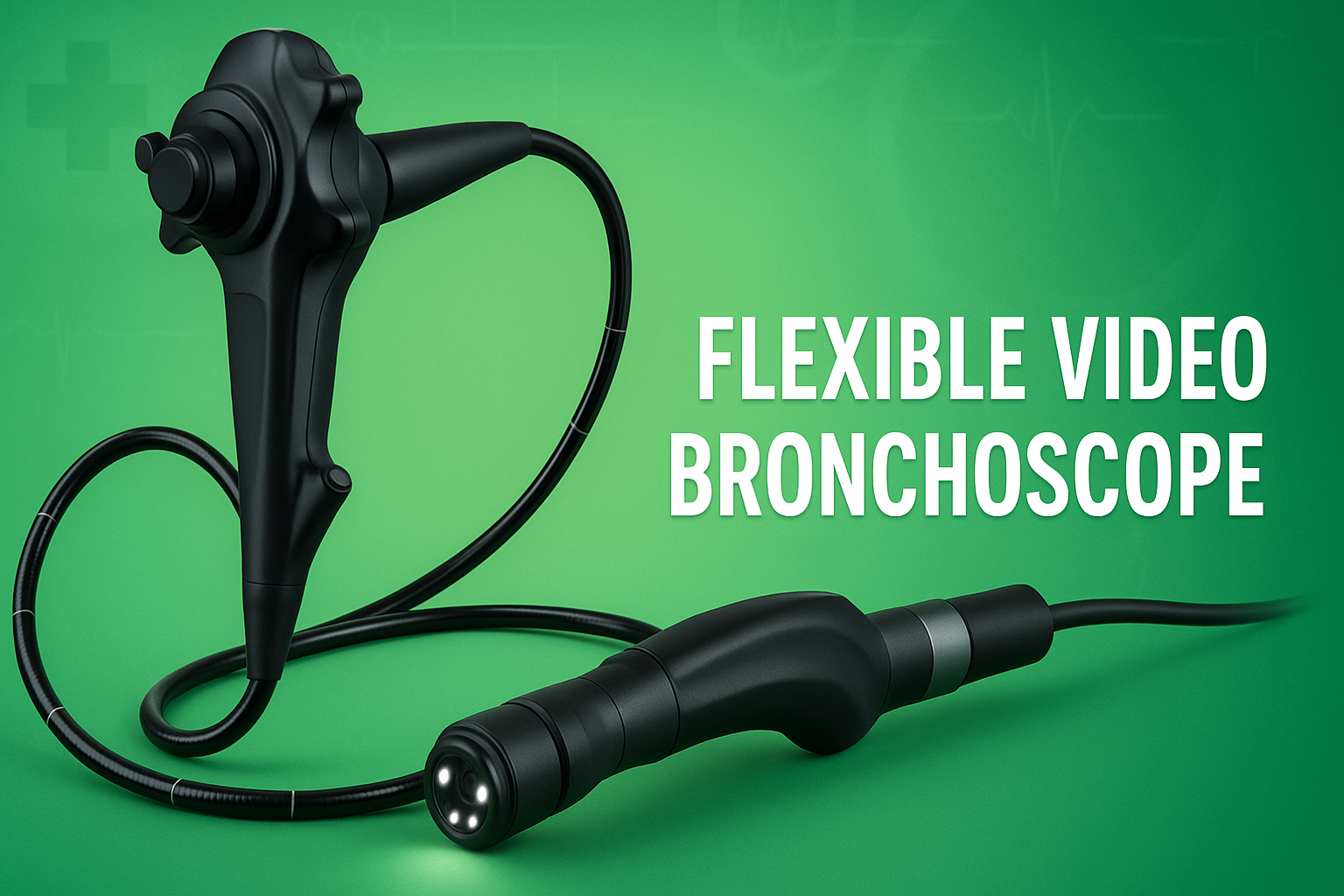The Growing Role of Flexible Video Bronchoscope in Modern Pulmonology
In recent years, the Flexible Video Bronchoscope has become an indispensable tool in respiratory medicine, revolutionizing the diagnosis and management of airway and lung diseases. This advanced instrument essentially a flexible, fiber-optic or video-equipped tube is designed to be threaded through a patient’s nose or mouth into the airways, providing clinicians with a real-time, high-definition view of the bronchial tree. Its flexibility allows it to navigate complex airway anatomy with minimal discomfort, making it superior to traditional rigid bronchoscopes in many clinical settings. Through enhanced visualization and maneuverability, the flexible video bronchoscope enables physicians to perform delicate diagnostic and therapeutic procedures from biopsy and lavage to foreign body removal with greater safety and efficacy.
Origins and Evolution
The journey toward modern flexible bronchoscopes began in the mid-20th century, when rigid bronchoscopes were the mainstay. While effective, rigid scopes were bulky, less comfortable for patients, and limited in reach. The invention of fiber optics and, later, video chip-on-tip technology paved the way for more slender, flexible devices that could traverse narrower and more distal airways. Over time, manufacturers refined image quality, articulation, channel size, and ergonomics. Today’s devices combine high-resolution imaging with improved illumination, angulation, and accessory compatibility enabling a broad array of interventions that were once impossible or highly risky.
Key Components and Design Features
A typical flexible video bronchoscope consists of several essential parts:
-
Insertion tube: A slender, flexible shaft that houses the optical fibers or video elements, light delivery system, and working channels.
-
Tip and articulation system: The distal tip can be angled in multiple directions (up, down, left, right) via control wires or motorized systems, facilitating navigation even around tight turns.
-
Light source and illumination: High-intensity light, often LED or xenon, is delivered through fiber optics or built into the tip for optimal visualization.
-
Imaging system: Modern scopes use CCD or CMOS sensors at the tip, producing real-time video images transferred to external monitors.
-
Working channels: These allow passage of instruments (forceps, brushes, suction, lasers, stents) or instillation of fluids.
-
Control head and ergonomics: The operator holds a control section that integrates angulation knobs, suction/air valves, and sometimes controls for imaging or channel flushing.
To meet clinical demands, design considerations balance diameter (smaller allows better access), robustness, clarity, flexibility, sterilizability, and compatibility with accessories.
Clinical Applications
Diagnostic Use
One of the primary uses of flexible video bronchoscopes is in diagnosing lung and airway diseases:
-
Visual inspection: Detecting tumors, inflammation, strictures, bleeding sites, and other airway abnormalities.
-
Bronchoalveolar lavage (BAL): Flushing fluid into a bronchial segment and retrieving it for cytology, microbiology, or immunologic studies.
-
Transbronchial biopsy and brushing: Harvesting tissue or cells from lung parenchyma or lesion margins for pathological examination.
-
Endobronchial ultrasound (EBUS): Some flexible bronchoscopes integrate ultrasound probes to assess structures adjacent to airways, such as mediastinal lymph nodes.
Therapeutic Use
Beyond diagnosis, these devices play key roles in therapy:
-
Foreign body removal: Grasping and extracting inhaled objects, especially in children.
-
Airway stenting and dilation: Placing or expanding stents to relieve obstructions.
-
Endobronchial laser or electrocautery: Ablation of obstructing lesions.
-
Cryotherapy: Freezing unwanted tissue under video guidance.
-
Therapeutic lavage and suction: Clearing mucus plugs, secretions, or blood clots.
Intensive Care and Critical Care
In intensive care settings, flexible bronchoscopes assist with:
-
Guiding tracheal intubation: Especially in difficult airway situations.
-
Suctioning distal secretions: For ventilated patients with secretion retention.
-
Assessing airway complications: Such as ventilator-associated pneumonia or airway trauma.
Advantages Compared to Rigid Bronchoscopes
-
Greater reach and flexibility: Able to navigate deeper into bronchial segments.
-
Less discomfort for patients: Can be done under sedation rather than full anesthesia.
-
Improved safety in fragile patients: Less risk of airway trauma.
-
Better for outpatient or procedural settings: More versatile and portable.
-
Enhanced image quality: Modern scopes provide crisp, digital video.
However, rigid bronchoscopes still have advantages for certain heavy-duty interventions, such as large airway tumor resections or major bleeding control.
Technical Challenges and Limitations
While transformational, flexible video bronchoscopes come with limitations:
-
Fragility and maintenance: The optics, articulation wires, and light fibers are delicate—and repairs and maintenance can be costly.
-
Limited suction and instrument size: The small working channels impose constraints on instrument size and clearance.
-
Field of view and depth perception: Two-dimensional imaging may hamper spatial judgment in some maneuvers.
-
Cost and resource demands: High-end scopes and their accessories can be expensive, and require infrastructure like sterilization facilities and video systems.
-
Skill dependency: Effective use demands training and experience to navigate complex anatomy and perform safe interventions.
Best Practices in Clinical Use
To maximize safety and effectiveness, clinicians and institutions adopt best practices:
-
Proper training: Simulation and supervised use help novices gain competence without undue patient risk.
-
Preprocedure planning: Review imaging (CT, MRI) to anticipate airway anatomy, obstructions, or deviations.
-
Patient preparation and sedation: Adequate topical anesthesia, sedation, and patient monitoring reduce cough, movement, and complications.
-
Sterilization protocols: Adherence to high-level disinfection or sterilization is critical to prevent infections.
-
Periodic inspection and maintenance: Regular testing of optics, bending sections, leak testing, and servicing prolong device life.
-
Quality assurance and documentation: Recording video or stills, maintaining logs, and auditing outcomes help improve care.
Emerging Trends and Innovations
Technological advances are pushing the capability of flexible bronchoscopes further:
-
High-definition, ultra-thin scopes: Offering clearer images through narrower diameters, allowing access to more peripheral airways.
-
3D imaging and stereoscopic vision: Enhancing depth perception to improve procedural safety.
-
Robotic bronchoscopy: Robotic arms guide the flexible scope with higher precision and stability in distal lung regions.
-
Integration with navigation systems: Electromagnetic or virtual bronchoscopy aids in steering the scope to peripheral targets.
-
Disposable bronchoscopes: Single-use scopes reduce cross-contamination concerns and maintenance burden, though cost per use is a factor.
-
Combined modalities: Merging bronchoscopy with ultrasound, optical coherence tomography, fluorescence imaging, or molecular probes to detect disease on a microscopic scale.
Clinical Impact and Future Prospects
The flexible video bronchoscope has transformed pulmonology by enabling less invasive, more precise interventions across a wide spectrum of respiratory disorders. Early and accurate diagnosis of lung cancer, interstitial lung disease, airway infections, and bronchiectasis has improved patient outcomes. Interventional bronchoscopy now handles what once required open surgery such as stent placement or tumor debulking with lower morbidity.
Looking ahead, as robotics, imaging, artificial intelligence (AI), and miniaturization continue to evolve, flexible bronchoscopes will likely become more intelligent and autonomous. AI could assist in nodule detection or guide instrumentation during biopsy. Robotic systems may extend the reach into the lung periphery and reduce operator fatigue or error. Single-use and telemedicine-compatible scopes might democratize access even in resource-limited settings.
However, challenges remain: cost-effectiveness, training disparities, maintenance burdens, and integration into clinical workflows. The future success of flexible video bronchoscopy will rest on balancing cutting-edge innovation with accessibility, affordability, and safety.
Conclusion
In summary, the flexible video bronchoscope stands as a pivotal advancement in the field of respiratory medicine. Its flexibility, refined imaging, and compatibility with a wide range of diagnostic and therapeutic tools have redefined what is possible in airway care. While not without limitations, the scope’s evolution continues apace driving better patient outcomes, fostering new methods of intervention, and promising a future in which lung diseases are diagnosed earlier, treated more precisely, and managed more safely.







